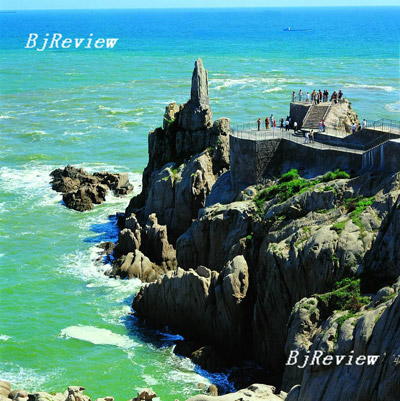|

If the territory of China's mainland is shaped like a rooster, then the port city of Rongcheng, in Shandong Province, would be its beak. Jutting out from the northern part of China's east coast, it is one of the earliest cities on the Chinese mainland to see the sunrise. That explains why over 2,100 years ago the first emperor of a united Chinese kingdom, Qinshihuang, had been to Rongcheng twice to pay homage to the god of sun.
Today, this sun-kissed city with its unique geographical location, rich fishing resources and stunning seaside views is building itself into a top-ranking industrial base, a favorite foreign investment destination and a tourism resort in China.
Industrial clout
While people here used to base their economy on fishing and agriculture-Shandong Province produces the best quality peanuts and apples in China-the economic pillars are the shipbuilding industry, auto parts production and agricultural product processing. With an industrial output now accounting for about 60 percent of its gross domestic product, the city has evolved into an industrial port of note.
Shipbuilding is a startup industry for the city. After a capital injection of 13 billion yuan, the city has gained annual production capacity of 1.5 million deadweight tons. This figure has propelled the city into a major shipbuilding power in China.
A large proportion of investment in shipbuilding and auto parts manufacturing is from overseas investors, including the global Fortune 500 companies of American Cooper Tire & Rubber Company and South Korean Hyundai Motor. To date, the city has maintained trade relations with over 100 countries and regions and attracted investment from 30 countries and regions. Rongcheng has established sister city relationships with cities from South Korea, Japan, the United States and Iceland.
Among the 162 projects planned for 2006, the largest is the construction of a nuclear power project, which will absorb a total investment of 40 billion yuan from China Huaneng Group, China National Nuclear Corp. and Tsinghua University.
Attractive to investors
The attraction for foreign investors to the city is partly attributed to its advantageous geographical conditions. Rongcheng is the nearest city to South Korea, with a direct distance at the nearest point being only 94 sea miles. Back in the Tang Dynasty (618-907), Rongcheng was the famous marine trade center between South Korea, China and Japan. When China adopted reform and opening up policies in the late 1970s, Rongcheng was among the first cities ratified to adopt favorable policies to foreign investment.
The local government has been devoted to making the city an investment paradise featuring an excellent investment environment, with low costs and high return rates. First of all, government continues to improve production facilities and layout in industrial parks. The power supply for new companies has been guaranteed with the completion of power stations in recent years, which boosts the total installed capacity in the industrial parks to nearly 6 million kw. Foreign investors can rent at a preferential rate or purchase production facilities with finished housing in different sizes. Second, government offers incentives to foreign investment in the use of land and taxation and set up government branches to solve problems investors meet in their operation. Third, local government attaches great importance to creating an enjoyable life for foreign investors. Besides producing television programs in Korean language, government has also built entertainment facilities and international kindergartens and schools for children of South Korean investors.
Tourism potential
 A trip to Rongcheng would delight seafood lovers. The long history of deep sea fishing enables the city to offer over 150 varieties of seafood. Surrounded by sea on three sides, there are over 100 fishing docks, with Shidao-meaning rock island in Chinese-the biggest fishing harbor in northern China. Another plus is the largest inshore fishing farm in China, where sea kelp, abalone and other kinds of sea fish are bred. Generous supplies of seafood delicacies are shipped to markets in Japan, South Korea and several Southeast Asian nations. The city has 470 seafood processing companies, whose frozen seafood, medication and nutrition additives extracted from seafood have a broad market in China and overseas. A trip to Rongcheng would delight seafood lovers. The long history of deep sea fishing enables the city to offer over 150 varieties of seafood. Surrounded by sea on three sides, there are over 100 fishing docks, with Shidao-meaning rock island in Chinese-the biggest fishing harbor in northern China. Another plus is the largest inshore fishing farm in China, where sea kelp, abalone and other kinds of sea fish are bred. Generous supplies of seafood delicacies are shipped to markets in Japan, South Korea and several Southeast Asian nations. The city has 470 seafood processing companies, whose frozen seafood, medication and nutrition additives extracted from seafood have a broad market in China and overseas.
With 10 bays, over 30 islets and 10 natural bathing beaches along its coastline, Rongcheng is an ideal place for beach lovers to catch up on their tans in summer. It also boasts the cleanest air and sea water in China, along with the first national wetland park in a city proper, making this the envy of all other municipalities on the mainland. Figures local residents are proud of include the 46 percent urban green space coverage and per-capita green space of 26 square meters, among the highest in the country.
Bird watchers will feel they have flown home to roost in Rongcheng. A natural islet reserve provides the perfect habitat for over 10,000 seagulls and egrets. The city is also the world's fourth largest swan habitat in terms of the swan population. Every winter, over 10,000 swans migrate to spend winter in a five-square-km lake in Rongcheng. In recent winters, the population of swans living along the city's coastline has experienced a sharp rise due to the favorable natural environment.
Visitors keen on sampling the authentic lifestyle of farmers in one of the fishing villages are invited to do so. Local farmers at seaside villages offer accommodation at their homes, and provide a variety of interesting activities that include everything from folk singing lessons to gardening tips.
Despite all its abundant charms, the city hasn't had many opportunities to market itself internationally. Its sole opportunity came in September 2002, when it successfully hosted an international symposium and exposition on sea fishing and processing of marine products. The local government is, however, determined to seek more avenues to promote Rongcheng to a global audience of investors and tourists alike.
| 